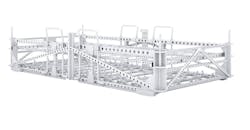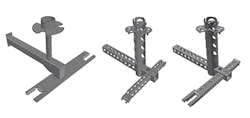Lighter, Lower-Profile Carriers Result in Better Heat Treating
Foundries that install heat-treating capability may not realize all the factors contributing to the efficiency and productivity of that process. StrikoWestofen, a furnace builder more recognizable for melting and holding systems, reported it took “a holistic, process-oriented heat treatment approach in which the interplay of furnace system, quenching unit, and product carrier is fine-tuned.” The resulting, minimized design for the product carrier increases process capacity while reducing energy consumption and the number of rejected parts. “This unique approach really makes a difference for our customers and has a substantial impact on their bottom line,” according to Striko’s Rudi Riedel.
The redesign effort reduced the weight of product carrier mountings from 4 kg to about
2.5 kg, which results substantial annual energy savings.
Heat treatment is a multi-stage process that is becoming more necessary for light metal castings, particularly for automotive parts. Today, heat treatment is applied not only to engine parts or wheel rims, which must achieve high stress-resistance, but also to safety-critical body and chassis structures.
The purpose of heat treatment is to optimize material properties, to achieve greater ductility, hardness and tensile strength, as well to eliminate residual mechanical stress. Generally, there are three process stages — solution annealing, quenching, and ageing — and the parts are mounted on product carriers throughout.
This is why product carriers became the starting point for StrikoWestofen’s development of a heat treatment system. Noting that the team built multiple prototypes and conducted numerous tests, Riedel said, “the outcome is very promising.”
The resulting design achieves considerable savings compared to standard product carriers, thanks to reduced alignment work, increased throughput, improved process reliability and low energy consumption.
Heat treatment releases residual stresses that may lead to distortion in finished parts. In order to match the tolerances specified by customers, any distortions must be reduced through manual or mechanical alignment. The cost for this can be reduced by using optimized product carriers: the design of the frame mountings ensures an even transfer of heat to the component and uniform cooling via water, air or an air/water mixture. Simulation, thorough measurement, and sophisticated heat treatment tests help to ensure consistent quality and precise design of the carriers.
Packing density (and thus, throughput) of the heat treatment system can be increased by incorporating fewer profiles and fixtures, which are tailored to the components they support. Additive manufacturing processes and precision measuring of individual product carriers prior to delivery guarantee repeatability and stability of the heat treatment process
Rather than heavy frame profiles, StrikoWestofen offers weight-reduced frames, which means less overall mass to be heated up and cooled down, not only saving energy but reducing solution annealing and quenching times, too. Finally, the carriers are made from stainless (not carbon) steel, preventing corrosion and rust and enhancing durability.
“Product carriers are an often underestimated but essential component of the heat treatment process,” summarized Riedel. “Innovative developments in this field make an important contribution to the reduction of the costs per casting and help our customers to maintain their competitive advantage.”
About the Author
Robert Brooks
Content Director
Robert Brooks has been a business-to-business reporter, writer, editor, and columnist for more than 20 years, specializing in the primary metal and basic manufacturing industries. His work has covered a wide range of topics, including process technology, resource development, material selection, product design, workforce development, and industrial market strategies, among others.

